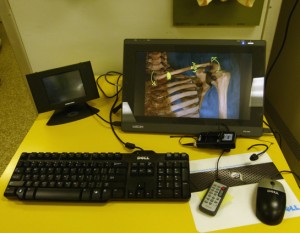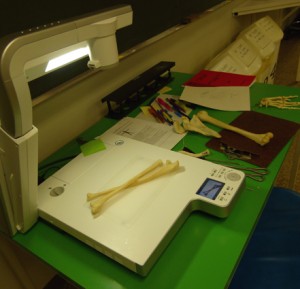Tuesday 12th July, 2011
Anatomy Laboratory, School of Medicine, Flinders University
2nd year Meds, Musculoskeletal Lecture & Practical Session:
Upper Limb ( bones)
This was no ordinary Tuesday. Ian and I talked about it the following morning.
Here are some of my thoughts and observations…
Of course classes can vary from week to week but we had both noticed a distinct energy amongst the students during Tuesday’s practical anatomy class on the bones of the upper limb. They seemed so absorbed in their individual experiences with the material and especially in the referencing of their own bodies. And I know it’s relatively early days in this course, but usually there’s a sense of urgency and a palpable anxiety amongst the students. This is serious business. Everyone is aware of the huge amount of material that must be learned to get through the exams and that is all there is time for.
I’ve been wondering if the students are becoming a little more comfortable with the material they must learn for this course because Ian is always gently reminding them that their own bodies are totally relevant source material. Yes, I know he always does that but something’s different of late. Is it Ian’s teaching? Is it the students? Is it our awareness?
I’m more aware now of the various kinds of direct and indirect experiences in MMS prac lessons and that they are quite specific to learning human anatomy – the types, combinations and sequencing of experiences and the proximity and accessibility of forms of representation are unique to that teaching and learning environment. There is a constant interplay between internal and external referencing during a class.
I’m beginning to think that even before we get to the subject matter, that a cultivation of awareness is critical. It may seem obvious, but unless each person is directed to engage in these kinds of hands-on experiences – how are they to know what they don’t know?
How are they to know what is possible to know in this way?
The instructor’s physical presence and guidance are critical. But it is not as simple as saying…well it’s all here, get your hands on it! Although this kind of encouragement to handle the objects is important, the critical influence is also in the sequencing of experiences to be had in that special room. For example, there was a moment during Tuesday’s class when Ian suggested that the students have a close look at an Xray of a shoulder joint on a light box at one end of the room. ( I noticed the image was actually displayed at shoulder height). The Xray had a few critical features identified with red code stickers and Ian told the students that this would most likely be in the exam. He then advised them to go to the skeletons on stands and identify the same features and also to feel the corresponding bony landmarks on their own bodies. All the while Ian was casually tracing the bones of his own shoulder.
During the afternoon I began to take in other ‘vignettes’ of action around the classroom. I noticed a student standing directly in front of a skeleton, shoulder to shoulder, one hand on his own shoulder, the other feeling the boney joint of the skeleton and right next to him a group of three students standing close to one another in a circle, simultaneously cupping their own shoulders, fingertips on clavicles and moving their whole arms in large slow arcs in space. I was surprised that they weren’t testing each other by naming the structures as they usually do. They were simply looking at each other rather introspectively, deep in sensation, occasionally nodding. They weren’t rushing, they just seemed to be taking in their own experiences, in their own time.
As per usual, all around on the tables were the loose dry bones of the upper limb, plastic shoulder joints on stands, radius and ulna still under the overhead projector projected on the screens all around the space and the wet prosections of wrist and shoulder joints sitting on the stainless steel trolleys.
The atmosphere was decidedly calm, the students seemed constantly engaged, always in movement and…yes, really enjoying themselves!
Ian tells me that the tutors are reporting that this group of MSS students are grasping the material quite quickly and they say they are enjoying the prac classes in particular because of the hands on experience. Most say the experience clarifies the three-dimensional aspects of the subject matter. The tutors have also noticed that the students have already formed quite close-knit study groups.
I will ponder the subtleties of the day further with Ian next week.
Oh yes…and we have received approval from the Social and Behavioural Research Ethics Committee to document students’ hands during the pracs. The trick will be to remain in the background as much as possible so as not to inhibit the class’s usual unusual behaviour!


